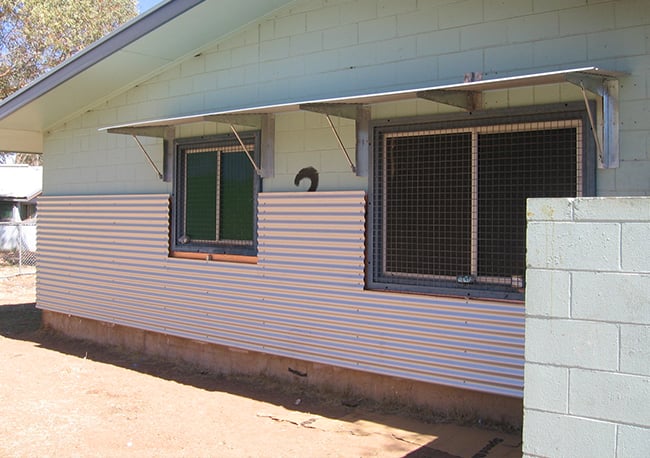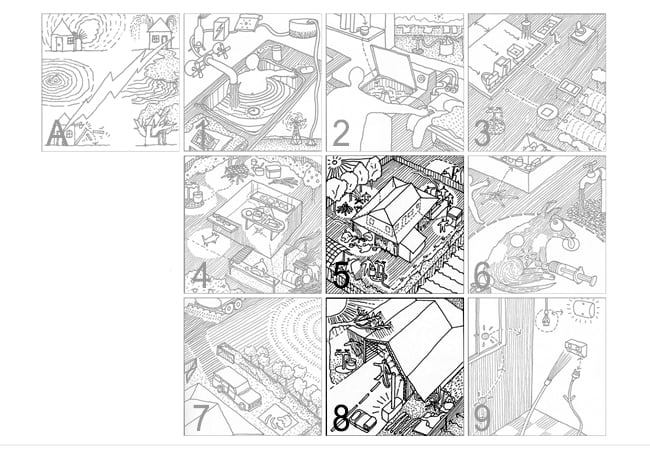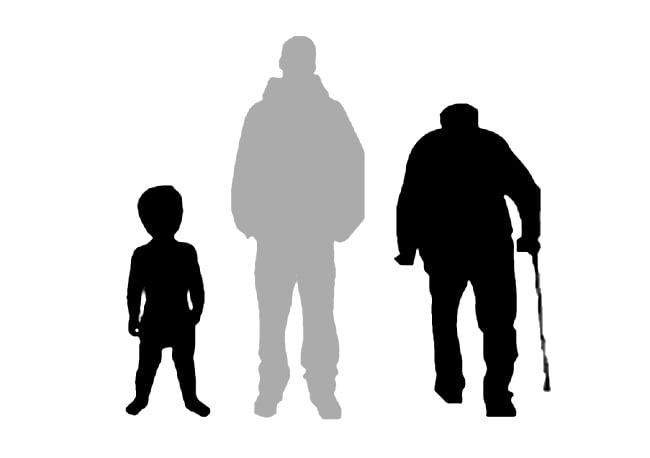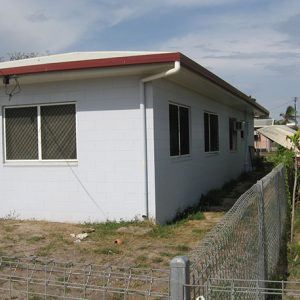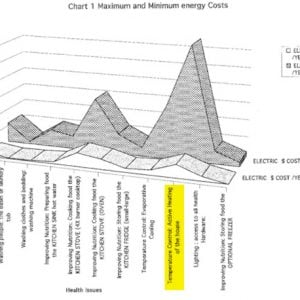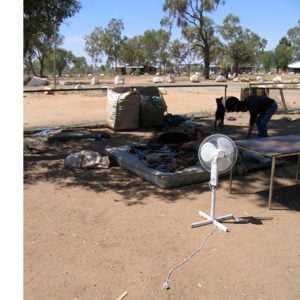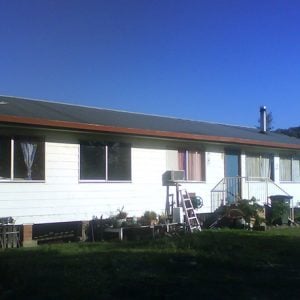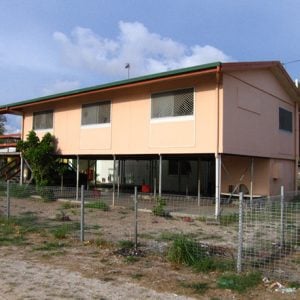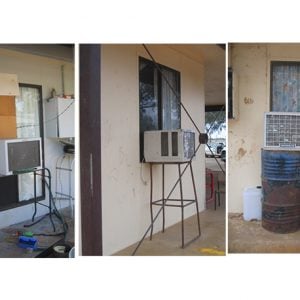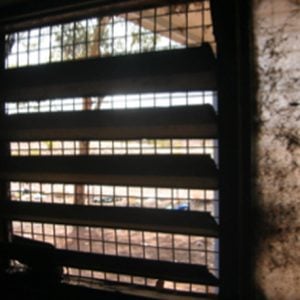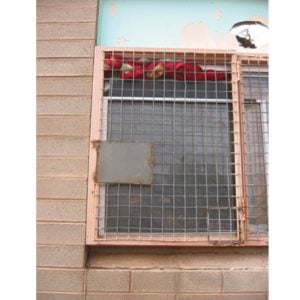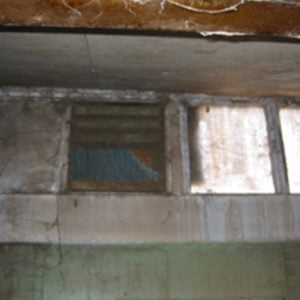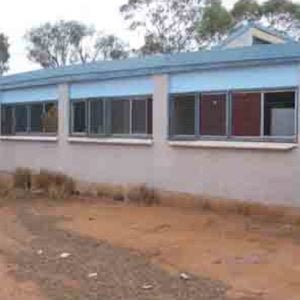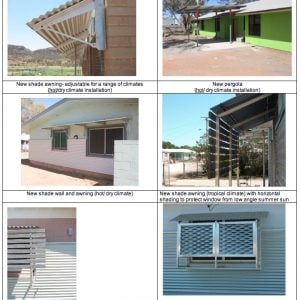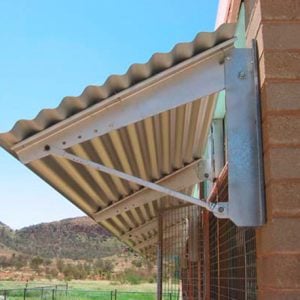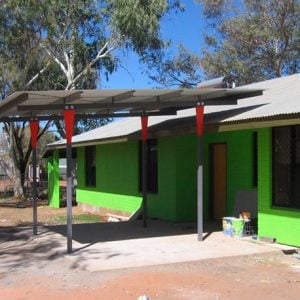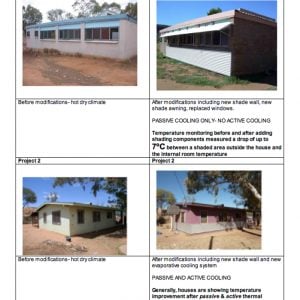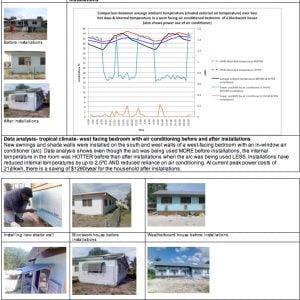Research and Development
Temperature Control Inside the House – cool houses in hot climates
Project Details Better Indoor Living - Temperature Control
- Introduction
- The Problem
- The Solution
- Trial projects
- Trial Project A - Temperature Control Project- Hot/dry Climate (summer)
- Trial project B - Temperature Control Project- Tropical Climate
- Where to next?
- From Housing for Health - the Guide
Introduction
In hot climates, it can often be hotter inside the house than outside in the shade under a tree. Extremes in temperature inside houses can impact on the health of people.
People compensate for temperature extremes by installing air conditioning. In remote areas air conditioning can cost as much as $25/day in summer. As part of the project existing houses were modified in a range of climates, to make them warmer in winter and cooler in summer. The aim was to reduce the reliance of active cooling (and heating) by reducing the number of days in the year air conditioning is required.
This project looks at climates where the predominant issue is keeping householders cool in a hot climate ie. where there is a greater proportion of the year where householders experience thermal stress due to heat rather than cold. For example, Alice Springs, a hot dry climate in Central Australia.
See “Temperature Control Inside the House- Warm house in cold climates” for thermal stress experienced due to cold temperatures.
The Problem
In hot climates, it can often be hotter inside the house than outside in the shade under a tree.
| Average outside air temperature in hot conditions when temperatures are over 30ºC | 34ºC |
| Average temperature inside the house in hot conditions when temperatures are over 30ºC | 31ºC 35% of over 9000 houses surveyed had outdoor temperature greater than 30ºC. 21% of these houses provided no improvement on outside air temperatures |
 Principles of thermal mass (See Your home website) | On a hot night, people may be better off sleeping outside on a verandah as an uninsulated brick house with a concrete slab floor would radiate heat back into the rooms, making it hotter inside than outside over night |
Reliance on expensive to run cooling (and heating) systems
When houses are too hot or too cold, with poor passive design, householders are often forced to buy active heating and cooling to make the house habitable.
Passive heating and cooling is any heating or cooling method that requires no energy input either by the house resident or a mechanical device.
Active heating and cooling involves the input of energy to the house. Ideally all active systems are as energy and water efficient as possible.
Heating and cooling systems can often be cheap to buy but very expensive to run. In a house, heating and cooling can account for a high proportion of the household’s total energy use. In remote areas air conditioning can cost as much as $25/day in summer. See graph of energy use in an existing house on the Anangu Pitjantjatjara Lands below.
When heating becomes unaffordable, it can sometimes lead to disconnection of the power source (eg. electricity or gas service).
The householders then do not have electricity or gas available to perform the nine healthy living practices. For example, power to heat hot water to wash people or power for fridges, stove and ovens.
Reasons houses are too hot
- Poor orientation – The house is not sited to be protected from hot summer sun or hot breezes or to allow the sun in the cold winter months
- No wall or roof insulation – (26% had wall insulation, 37% had roof insulation)*
- Unshaded walls& windows – There may not be any roof eaves overhanging the walls and windows which allows direct sun in to heat up rooms (51% were sun protected)
- No verandahs – (44% had none or only one side of the house with a verandah)
- Inadequate ventilation
- Lack of shade or windbreak planting – (60% of houses surveyed had shade planting , 27% had windbreak planting)
- No cooling system installed – (33% of houses had no cooling system. Of those houses that had a cooling system, 42% had ceiling fans)
(NOTE: “active cooling and heating” should only be supplementary to “passive heating and cooling” measures or it is not affordable for occupants to run)
*Data prepared by Healthabitat for the Housing for Health – the Guide for over 9000 houses
The Solution
In trial projects (discussed below) modifications have been made to existing houses to make them warmer in winter and cooler in summer.
These include passive and active modifications.
Passive* modifications made to houses include:
- Shade awnings to shade walls & windows
- Shade walls to shade uninsulated walls
- Roof insulation
- New pergolas or re-roofing existing pergolas
- Roof vents to exhaust hot air from ceiling spaces
* Passive heating and cooling is any heating or cooling method that requires no energy input either by the house resident or a mechanical device.
Only after passive modifications are made to houses should active modifications be considered if required. Otherwise the running costs of the active system will be unaffordable for residents. * Active heating and cooling involves the input of energy to the house. Ideally all active systems are as energy and water efficient as possible. One project in Central Australia had ducted evaporative cooling installed in houses.
Trial projects
Background – different climates in Australia
a) Hot/dry climate
b) Tropical climate
Trial Temperature Control Projects- Background
Project Aim
To make houses warmer in winter and cooler in summer, in climates where people experience thermal stress due to extremes in temperature.
To consider low maintenance passive temperature control measures and to reduce long term running costs of active temperature control.
Project Outline
To produce a kit of parts able to be used on many houses to reduce extremes in internal temperature for minimal cost. The designed parts can be used on existing houses and integrated more fully into new house designs.
Project Implementation
Data measuring equipment was installed in a selection of houses. The houses had varying construction types. Ambient (shaded external air temperature) and internal room temperature was recorded before and after modifications were made to houses.
Trial Project A - Temperature Control Project- Hot/dry Climate (summer)
Modifications to houses
Passive* modifications made to houses to make them cooler in summer included:
- Shade awnings to shade walls & windows
- Shade walls to shade uninsulated walls
- Roof insulation
- New pergolas or re-roofing existing pergolas
- Roof vents to exhaust hot air from ceiling spaces
Active* modifications:
One project involved FIRSTLY installing passive modifications (listed above) and then installing evaporative coolers.
Without installing passive modifications first, active cooling would be unaffordable for residents.
Cost/house @ 2007 in Central Australia
Free standing shade structure, wall mounted shade awnings and shade walls= $13 000
Temperature Reduction & payback time
Results from the completed project in the hot dry climate showed that on a 43ºC day, after modifications had been made to a blockwork house, (see picture below) internal temperatures were up to 7ºC below the shaded ambient air temperature. Internal temperatures were up to 4ºC cooler than the same room before modifications were installed.
Trial project B - Temperature Control Project- Tropical Climate
Modifications to houses
Passive* modifications made to houses to make them cooler in summer included:
- Shade awnings to shade walls & windows with shading over windows (horizontal battens or aluminium screens)
- Shade walls to shade uninsulated walls (new frames fixed to existing walls & clad with new insulation & new customorb)
- New pergolas
Cost/house @ 2011 in Central Australia
Total cost/ house for installations was $3954 to $16171. Higher costs included installation of pergolas.
Temperature Reduction & payback time
Installations to one blockwork house with an air-conditioned room have reduced internal temperatures by up to 2.5ºC AND reduced reliance on air conditioning. At current power costs of 21¢/kwh, there is a saving of $1280/year for the household after installations. Payback time for installations is 3-6 years depending on carbon tax impacts on fossil fuel electricity costs.
Where to next?
For information for architects, designers, students, communities, housing managers go to :
B8 Controlling the temperature of the living environment
B8.1 Human comfort and climate
B8.2 Passive design in tropical zones
From Housing for Health - the Guide
B8.1 Human comfort and climate
Heat
All people constantly produce heat. To remain comfortable in a warm or hot climate, the body tries to lose heat at the same rate, or even a higher rate, than it is produced. The body’s natural way of losing heat is to sweat because the process of evaporating the sweat from the skin removes heat from the body. Australian research shows that, on average, the body can maintain comfort until the temperature is 29.5ºC. In higher temperatures, people usually start to feel uncomfortable.
Learn More

